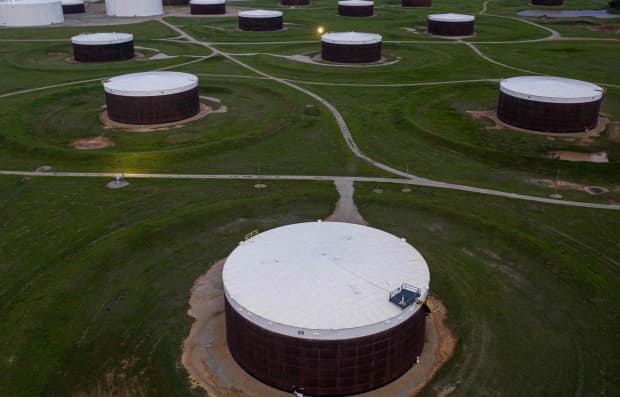Johannes Eisele/Agence France-Presse/Getty Images
January Brent crude BRNF21, 2.08% BRN00, 2.08%, the global benchmark, added 72 cents, or 1.7%, to $44.47 a barrel on ICE Futures Europe.
Both WTI and Brent crude prices, based on the front-month contracts, were on track to mark their highest settlements since early September, FactSet data show.
The Energy Information Administration reported Wednesday that U.S. crude inventories rose by 800,000 barrels for the week ended Nov. 13.
That was bigger than the 100,000-barrel climb forecast by analysts polled by S&P Global Platts, but the American Petroleum Institute reported on Tuesday a much larger 4.2 million-barrel increase.
January Brent crude BRNF21, 2.08% BRN00, 2.08%, the global benchmark, added 72 cents, or 1.7%, to $44.47 a barrel on ICE Futures Europe.
Both WTI and Brent crude prices, based on the front-month contracts, were on track to mark their highest settlements since early September, FactSet data show.
The Energy Information Administration reported Wednesday that U.S. crude inventories rose by 800,000 barrels for the week ended Nov. 13.
That was bigger than the 100,000-barrel climb forecast by analysts polled by S&P Global Platts, but the American Petroleum Institute reported on Tuesday a much larger 4.2 million-barrel increase.
The EIA data also showed crude stocks at the Cushing, Okla., storage hub edged up by 1.2 million barrels for the week.
Gasoline supply, meanwhile, rose by 2.6 million barrels, but distillate stockpiles dropped by 5.2 million barrels. The S&P Global Platts survey had shown expectations for a supply climb of 300,000 barrels for gasoline and decline of 1.8 million barrels for distillates.
On Nymex Wednesday, December gasoline RBZ20, 1.92% rose 1.1% to $1.1657 a gallon and December heating oil HOZ20, 2.71% tacked on 2% to $1.2641 a gallon.
December natural gas NGZ20, 0.93% traded at $2.722 per million British thermal units, up 1.1%.
Traders also continue to weigh developments around the Organization of the Petroleum Exporting Countries and its allies, a group known as OPEC+. A committee on Tuesday failed to announce a recommendation on output curbs for the OPEC Conference on Nov. 30 and OPEC and non-OPEC ministerial meeting on Dec. 1.
“The delay in guidance on production policy wasn’t a surprise” and there will be “more clarity” at the end of the month, Tariq Zahir, managing member at Tyche Capital Advisors, told MarketWatch.
OPEC+ is scheduled to ease up on curbs beginning Jan. 1, but speculation has grown for a delay on worries the continued rise in COVID-19 cases will allow a surge in supplies barring further restraint.
“OPEC is leaving all doors open to see how much demand does get hit in the weeks ahead,” said Zahir. “It is also worth noting Libya oil production continues to increase with no restrictions on them until they hit their previous production levels.”
For now, energy prices “will continue to see weakness as further [COVID-related] restrictions are implemented here in the U.S.,” he added.

No comments:
Post a Comment